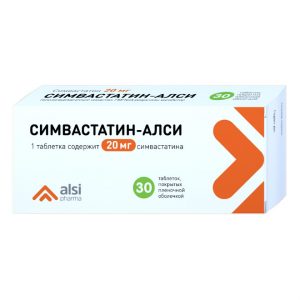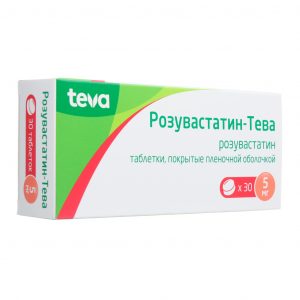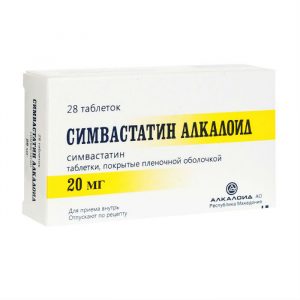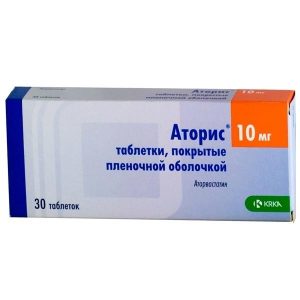Description
Packing
30 pcs.
Pharmacological action
Simvastatin – a lipid-lowering drug obtained synthetically from the fermentation product Aspergillus terreus, is an inactive lactone, undergoes hydrolysis in the body to form a hydroxy acid derivative. The active metabolite inhibits 3-hydroxy-3-methyl-glutaryl-CoA reductase (HMG-CoA reductase), an enzyme that catalyzes the initial formation of mevalonate from HMG-CoA. Since the conversion of HMG-CoA to mevalonate is an early stage in the synthesis of cholesterol, the use of simvastatin does not cause the accumulation of potentially toxic sterols in the body. HMG-CoA is easily metabolized to acetyl-CoA, which is involved in many synthesis processes in the body.
Causes a decrease in plasma triglycerides (TG), low density lipoproteins (LDL), very low density lipoproteins (VLDL) and total cholesterol (in cases of heterozygous familial and non-familial forms of hypercholesterolemia, with mixed hyperlipidemia, when high cholesterol is a risk factor).
Increases the content of high density lipoproteins (HDL) and reduces the ratio of LDL / HDL and total cholesterol / HDL.
The onset of the manifestation of the effect is 2 weeks after the start of administration, the maximum therapeutic effect is achieved after 4-6 weeks. The effect persists with continued treatment, with the cessation of therapy, the cholesterol content gradually returns to its original level.
Pharmacokinetics
Absorption of simvastatin is high. After oral administration, Cmax in blood plasma is reached after approximately 1.3 – 2.4 hours and decreases by 90% after 12 hours. Communication with plasma proteins is about 95%.
Metabolized in the liver, has the effect of first passing through the liver (it hydrolyzes to form an active derivative: beta – hydroxy acids, other active and inactive metabolites were found).
T1 / 2 of active metabolites is 1.9 hours. It is excreted mainly with feces (60%) as metabolites. About 10-15% is excreted by the kidneys in an inactive form.
Contraindications
Hypersensitivity
acute hepatic impairment
severe renal failure.
Use during pregnancy and lactation
Simvastatin may have an adverse effect on the fetus and is contraindicated in pregnant women. There are several reports of the development of abnormalities in newborns whose mothers took Simvastatin.
Women of reproductive age taking Simvastatin should avoid conception. The use of simvastatin is not recommended in women of childbearing age who do not use contraceptives. If pregnancy does occur during treatment, Simvastatin should be canceled, and the woman should be warned of a possible danger to the fetus.
There are no data on the excretion of simvastatin with breast milk. If it is necessary to prescribe Simvastatin during breastfeeding, it should be noted that many drugs are excreted in breast milk, and there is a risk of severe reactions, therefore breastfeeding while taking the drug is not recommended
Special instructions
A transient increase in liver enzymes is possible at the beginning of simvastatin therapy.
Before starting therapy and further regularly conduct a study of liver function (monitor the activity of liver enzymes every 6 weeks for the first 3 months, then every 8 weeks for the remaining first year, and then once every six months), as well as with increasing doses, liver function test. If the dose is increased to 80 mg, it is necessary to test every 3 months. With a persistent increase in the activity of transaminases (3 times compared with the initial level), the use of simvastatin should be discontinued.
Simvastatin, like other inhibitors of HMG-CoA reductase, should not be used with an increased risk of rhabdomyolysis and renal failure (against the background of severe acute infection, arterial hypotension, planned major surgery, injuries, severe metabolic disorders).
Withdrawal of lipid-lowering drugs during pregnancy does not significantly affect the results of long-term treatment of primary hypercholesterolemia.
Due to the fact that HMG-CoA reductase inhibitors inhibit cholesterol synthesis, cholesterol and other products of its synthesis play a significant role in the development of the fetus, including the synthesis of steroids and cell membranes, simvastatin may have an adverse effect on the fetus when prescribed to pregnant women (women of reproductive age should avoid conception). If pregnancy occurs during the treatment, the drug should be discontinued, and the woman should be warned of a possible danger to the fetus.
The use of simvastatin is not recommended in women of childbearing age who do not use contraceptives.
In patients with reduced thyroid function (hypothyroidism) or in the presence of certain kidney diseases (nephrotic syndrome) with an increase in cholesterol, the underlying disease should be treated first.
Simvastatin is prescribed with caution to individuals who abuse alcohol and / or have a history of liver disease.
Before and during treatment, the patient should be on a hypocholesterol diet.
Concomitant use of grapefruit juice may increase the severity of side effects associated with taking simvastatin, so you should avoid taking them simultaneously.
Simvastatin is not indicated in cases where there is type I, IV, and V hypertriglyceridemia.
Treatment with simvastatin can cause myopathy, leading to rhabdomyolysis and renal failure. The risk of this pathology increases in patients receiving at the same time as simvastatin one or more of the following drugs: fibrates (gemfibrozil, fenofibrate), cyclosporine, nefazadone, macrolides (erythromycin, clarithromycin), antifungal agents from the azole group (ketoconazole, intracoronazole) and HIV protease (ritonavir). The risk of developing myopathy is also increased in patients with severe renal failure.
All patients starting therapy with simvastatin, as well as patients who need to increase the dose of the drug, should be warned about the possibility of myopathy and the need to immediately consult a doctor in case of unexplained pain, muscle soreness, lethargy or muscle weakness, especially if accompanied malaise or fever. Drug therapy should be discontinued immediately if myopathy is diagnosed or suspected.
In order to diagnose the development of myopathy, it is recommended to regularly measure the amount of KFK.
In the treatment with simvastatip, an increase in the content of serum CPK is possible, which should be taken into account in the differential diagnosis of pain in the sternum. The criterion for drug withdrawal is an increase in the content of CPK in the blood serum by more than 10 times relative to the upper limits of the norm. In patients with myalgia, myasthenia gravis and / or a marked increase in CPK activity, drug treatment is discontinued.
The drug is effective both in the form of monotherapy and in combination with bile acid sequestrants.
If you miss the current dose, you must take the drug as soon as possible.
If it is time to take the next dose, do not double the dose.
In patients with severe renal failure, treatment is performed under the control of renal function.
The duration of the drug is determined by the attending physician individually.
Influence on the ability to drive vehicles and control mechanisms
An adverse effect of simvastatin on the ability to drive a car and work with mechanisms was not reported.
Composition of
active substance:
simvastatin 10 mg
Dosage and administration
Inside, once a day, in the evening, drinking plenty of water. The time of taking the drug should not be associated with a meal.
Before starting treatment with simvastatin, the patient should be prescribed a standard hypocholesterol diet, which must be followed throughout the course of treatment.
The recommended dose of simvastatin for the treatment of hypercholesterolemia varies from 10 to 80 mg once daily in the evening. The recommended starting dose for patients with hypercholesterolemia is 10 mg. The maximum daily dose is 80 mg.
Changes (selection) of the dose should be carried out at intervals of 4 weeks. In most patients, the optimal effect is achieved when taking the drug in doses up to 20 mg / day.
In patients with homozygous hereditary hypercholesterolemia, the recommended daily dose of Simvastatin is 40 mg once daily in the evening or 80 mg in 3 divided doses (20 mg in the morning, 20 mg in the afternoon and 40 mg in the evening).
In the treatment of patients with coronary artery disease or a high risk of developing coronary artery disease, effective doses of simvastatin are 20 40 mg / day. Therefore, the recommended initial dose in such patients is 20 mg / day. Changes (selection) of the dose should be carried out at intervals of 4 weeks, if necessary, the dose can be increased to 40 mg / day. If the content of LDL
In elderly patients and patients with mild or moderate renal failure, a change in the dosage of the drug is not required.
In patients with chronic renal failure (Cl creatinine
For patients taking amiodarone or verapamil concomitantly with simvastatin, the daily dose should not exceed 20 mg.
Side effects of the
Digestive system: constipation, diarrhea, loss of appetite, flatulence, nausea, abdominal pain, pancreatitis, increased activity of ALT, AST, GGT, alkaline phosphatase.
From the side of the central nervous system and peripheral nervous system: headache, dizziness, muscle cramps, paresthesia, peripheral neuropathy.
From the cardiovascular system: transient arterial hypotension is possible.
From the musculoskeletal system: myalgia, myopathy, rhabdomyolysis, increased activity of CPK.
Allergic reactions: rarely – angioedema, lupus-like syndrome, vasculitis, thrombocytopenia, eosinophilia, increased ESR, arthritis, urticaria, fever, shortness of breath.
Dermatological reactions: photosensitivity, skin rash, itching, flushing of the skin, alopecia.
Other: anemia.
Drug Interactions
Cytostatics, antifungal agents (ketoconazole, itraconazole), fibrates, high doses of nicotinic acid, immunosuppressants, erythromycin, clarithromycin, telithromycy, HIV protease inhibitors, nefazodone increase the risk of myopathy.
Cyclosporine or danazole: the risk of developing myopathy / rhabdomyolysis increases with the combined use of cyclosporine or danazole with high doses of simvastatin.
Other lipid-lowering drugs that can cause the development of myopathy: the risk of developing myopathy increases with the combined use of other lipid-lowering drugs, which are not powerful CYP3A4 inhibitors, but which can cause myopathy in monotherapy. Such as gemfibrozil and other fibrates (except fenofibrate), as well as niacin (nicotinic acid) at a dose of> 1 g / day.
Amiodarone and Verapamil: the risk of developing myopathy increases with the combined use of amiodarone or verapamil with high doses of simvastatin.
Diltiazem: the risk of developing myopathy is slightly increased in patients receiving diltiazem at the same time as simvastatin at a dose of 80 mg.
Simvastatin potentiates the action of oral anticoagulants (e.g. fenprocoumon, warfarin) and increases the risk of bleeding, which requires the monitoring of blood coagulation parameters before treatment, as well as often enough in the initial period of therapy. Once a stable level of prothrombin time index or International Normalized Ratio (MHO) is reached, further monitoring should be carried out at intervals recommended for patients receiving anticoagulant therapy. When changing the dosage or stop taking simvastatin, prothrombin time or MHO should also be monitored according to the above scheme.
Simvastatin therapy does not cause changes in prothrombin time and bleeding risk in patients not taking anticoagulants. It increases the level of digoxin in blood plasma.
Colestyramine and colestipol reduce bioavailability (the use of simvastatin is possible 4 hours after taking these drugs, with an additive effect).
Grapefruit juice contains one or more components that inhibit CYP3A4 and can increase the plasma concentration of drugs metabolized by CYP3A4. An increase in the activity of HMG-CoA reductase inhibitors after consuming 250 ml of juice per day is minimal and has no clinical significance. However, the consumption of a large volume of juice (more than 1 liter per day) when taking simvastatin significantly increases the level of inhibitory activity against HMG-CoA reductase in blood plasma. In this regard, it is necessary to avoid the consumption of grapefruit juice in large quantities.
Overdose
No specific symptoms were identified in any of the several known cases of overdose (maximum accepted dose of 450 mg).
Treatment: induce vomiting, accept activated charcoal. Symptomatic therapy. Functions of the liver and kidneys, the level of CPK in serum, should be monitored.
In the development of myopathy with rhabdomyolysis and acute renal failure (a rare but severe side effect), the drug should be discontinued immediately and diuretic and sodium bicarbonate administered (intravenous infusion). If necessary, hemodialysis is indicated.
Rhabdomyolysis can cause hyperkalemia, which can be eliminated by intravenous administration of calcium chloride or gluconate calcium, glucose infusion with insulin, use of potassium ion exchangers, or in severe cases, using hemodialysis.
Storage Conditions
In a dry, dark place at a temperature not exceeding 20 ° C.
active substance
Simvastatin
Terms leave through pharmacies
In retseptu
The dosage form of
tablet
Vertex, Russia




